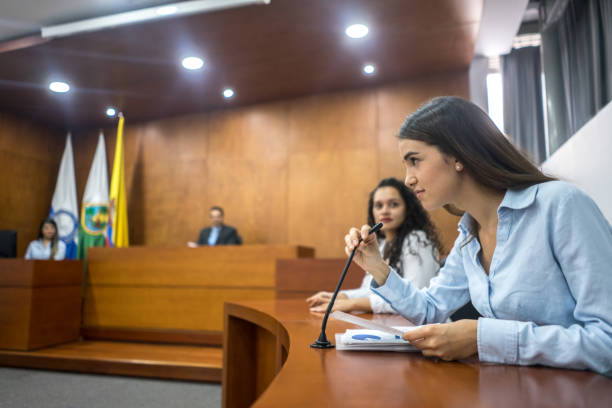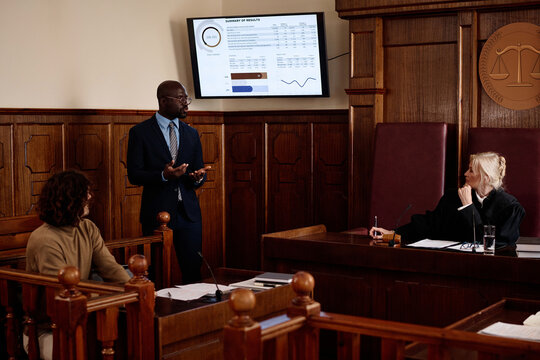Navigating the Intricacies of Test Presentations: Tips for Seamless Distribution and Compelling Arguments
In the world of legal proceedings, the art of trial presentation stands as a vital factor of success. The intricacies inherent in trial presentations need a fragile equilibrium of skill, method, and skill.

Understanding Test Purposes
To effectively navigate a trial, it is vital to have a clear understanding of the purposes that need to be accomplished. Prior to entering the court, lawful teams need to define their objectives and preferred results. These objectives work as directing principles throughout the test, forming methods and affecting decision-making processes.
Understanding trial goals involves a detailed evaluation of the case, lawful criteria, and the client's benefits. Trial Presentations. It requires a careful evaluation of the truths, identifying essential problems, and preparing for potential obstacles. By establishing specific and quantifiable objectives, attorneys can tailor their arguments and presentations to align with the wanted outcomes
Moreover, a clear understanding of trial purposes allows legal groups to focus on proof, witnesses, and lawful disagreements properly. It enables the growth of a meaningful narrative that reverberates with the judge and court, reinforcing the general situation discussion.

Organizing Proof Successfully
Having a clear understanding of trial goals lays the structure for arranging proof efficiently in legal proceedings. By straightening the presentation of proof with the preferred end results of the test, legal teams can strengthen their disagreements and improve their persuasiveness.
One more secret element in arranging evidence properly is developing a rational flow. Providing proof in a coherent and sequential manner can assist develop an engaging narrative that supports the lawful arguments being made. Furthermore, utilizing aesthetic help such as timelines, charts, or charts can additionally enhance the company of proof and help in clearing up intricate partnerships or series of events.
Furthermore, making certain that all proof presented is acceptable and appropriate to the situation is crucial. Inadmissible or irrelevant evidence can diminish the strength of the debate and possibly damage the credibility of the presenting event. For that reason, a meticulous evaluation and selection procedure ought to be taken on to include just one of the most legitimately sound and impactful proof in the test presentation.
Crafting Influential Stories
Crafting compelling narratives plays a critical duty in providing influential disagreements throughout legal proceedings. A well-crafted narrative has the power to captivate the audience, stimulate emotions, and eventually guide the decision in support of the presenting event. When creating a story for a test discussion, it is crucial to establish a clear story that highlights bottom lines and connects them in a coherent manner. Begin by laying out the truths of the instance in an engaging way, ensuring that the sequence of events is very easy to adhere to. Present personalities successfully, providing background info that aids the audience comprehend their inspirations and actions. In addition, including vivid descriptions and interesting language can bring the narrative to life, making it much more unforgettable for the discretionary. By weaving together proof, statement, and legal disagreements right into a influential and natural narrative, attorneys can properly advocate for their customers and boost the possibility of a beneficial end result in the court room.
Grasping Aesthetic Aids
Efficient use visual aids is vital to enhancing the influence and clarity of trial go to my site presentations. Aesthetic help, when used strategically, have the power to simplify complicated info, reinforce bottom lines, click for more and leave an enduring perception on the discretionary. To master visual aids in trial presentations, it is essential to make sure that they are clear, succinct, and appropriate to the debates being made.
When incorporating aesthetic aids, such as graphes, timelines, photos, or graphs, right into a trial presentation, it is vital to keep them visually appealing yet professional. The visuals should enhance the spoken debates, offering an aesthetic representation of the information being discussed without overwhelming the audience with unneeded information.
Furthermore, experimenting the aesthetic aids beforehand is necessary to guarantee a smooth delivery throughout the trial. Familiarizing oneself with the content, changes, and timings of each visual aid can help keep the flow of the presentation and prevent technical problems that might arise.
Delivering Impactful Closing Disagreements
An engaging closing disagreement acts as the conclusion of a trial presentation, enveloping the core story and persuading the judge and court in the direction of a beneficial choice. To deliver go to this web-site an impactful closing argument, it is critical to succinctly wrap up bottom lines, highlight the staminas of your case, and deal with any weaknesses in a strategic fashion. Begin by laying out the primary debates that support your client's placement, highlighting why the proof provided throughout the trial supports your story. It is important to develop a feeling of cohesion and clearness, leading the court and jury in the direction of the desired conclusion.
In addition, incorporating psychological allure can additionally enhance your closing disagreement. Ultimately, a well-crafted closing argument should leave a long-term impact, compelling the judge and court to rule in your client's favor.
Verdict
To conclude, grasping test discussions involves recognizing purposes, organizing proof, crafting narratives, making use of visual help, and delivering impactful closing debates. By applying these approaches successfully, attorneys can present their situation perfectly and make engaging arguments in the court. It is essential to browse the intricacies of trial discussions with accuracy and skill to attain success in lawful procedures.
By lining up the presentation of proof with the desired outcomes of the test, lawful teams can strengthen their arguments and boost their persuasiveness (Trial Presentations). To grasp aesthetic aids in test presentations, it is vital to guarantee that they are clear, succinct, and relevant to the arguments being made
An engaging closing disagreement serves as the conclusion of a trial discussion, enveloping the core story and convincing the court and jury towards a positive choice. Begin by describing the major debates that sustain your client's placement, highlighting why the proof offered throughout the test sustains your narrative.In verdict, mastering trial presentations entails understanding goals, organizing evidence, crafting stories, using visual help, and supplying impactful closing arguments.